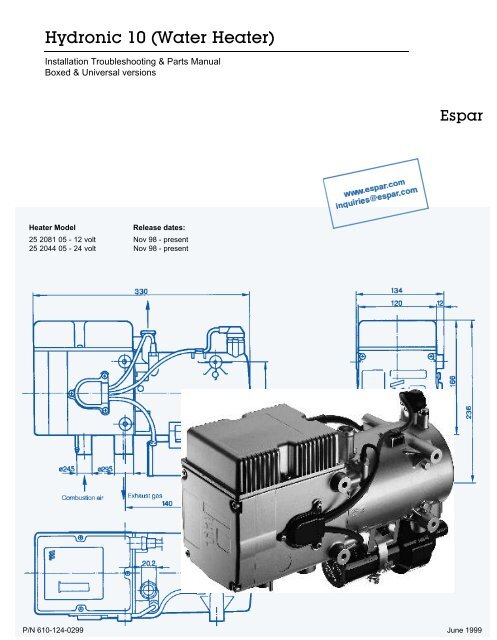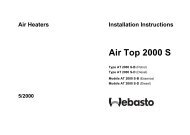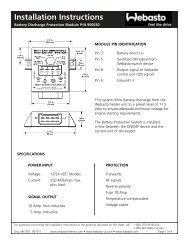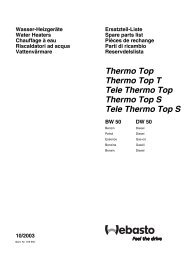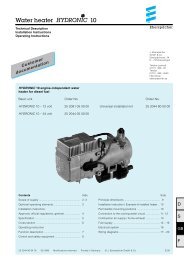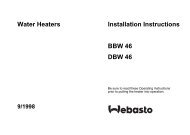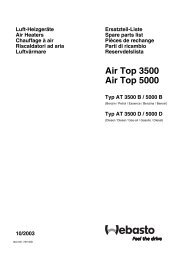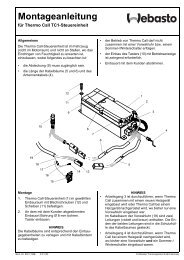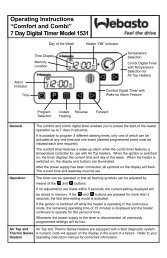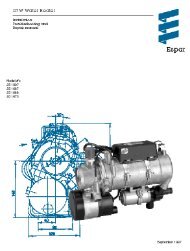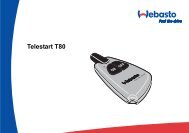Hydronic 10 (Water Heater) - Parts Manuals
Hydronic 10 (Water Heater) - Parts Manuals
Hydronic 10 (Water Heater) - Parts Manuals
Create successful ePaper yourself
Turn your PDF publications into a flip-book with our unique Google optimized e-Paper software.
<strong>Hydronic</strong> <strong>10</strong> (<strong>Water</strong> <strong>Heater</strong>)<br />
Installation Troubleshooting & <strong>Parts</strong> Manual<br />
Boxed & Universal versions<br />
Espar<br />
<strong>Heater</strong> Model<br />
Release dates:<br />
25 2081 05 - 12 volt Nov 98 - present<br />
25 2044 05 - 24 volt Nov 98 - present<br />
P/N 6<strong>10</strong>-124-0299 June 1999
Table of Contents<br />
Page<br />
Introduction <strong>Heater</strong> Warnings ........................................................ 3<br />
Introduction ........................................................ 4<br />
Specifications ........................................................ 4<br />
<strong>Heater</strong> Components ........................................................ 5<br />
Principal Dimensions ........................................................ 6<br />
Installation Procedures <strong>Heater</strong> Location ........................................................ 7<br />
<strong>Heater</strong> Mounting ........................................................ 7<br />
<strong>Heater</strong> Plumbing ........................................................ 8<br />
Fuel System ........................................................ 9<br />
Electrical Connections ........................................................ 11<br />
Exhaust/Intake Connections ........................................................ 12<br />
Operating Switches ........................................................ 13<br />
<strong>Heater</strong> Operation Pre-Start Procedures ........................................................ 15<br />
Start-Up ........................................................ 15<br />
Running ........................................................ 15<br />
Switching Off ........................................................ 15<br />
Safety Equipment ........................................................ 15<br />
Operational Flow Chart ........................................................ 16<br />
Wiring Diagram 12V boxed ........................................................ 17<br />
Wiring Diagram 24V boxed ........................................................ 18<br />
Wiring Diagram universal ........................................................ 19<br />
Maintenance, Periodic Maintenance ........................................................ 20<br />
Troubleshooting & Basic Troubleshooting ........................................................ 20<br />
Repairs Self Diagnostic Troubleshooting ....................................................... 20<br />
Fault codes/Description/Repair ....................................................... 21<br />
Fuel Quantity Test ........................................................ 25<br />
Repair Steps ........................................................ 25<br />
Resistance Values ........................................................ 27<br />
<strong>Heater</strong> Components <strong>Parts</strong> Diagram ........................................................ 28<br />
Description & Part #’s ........................................................ 29<br />
<strong>Parts</strong> - Boxed units ....................................................... 30<br />
Description & Part #’s ....................................................... 31<br />
<strong>Parts</strong> - Universal ....................................................... 32<br />
Description & Part #’s ....................................................... 33<br />
<strong>Parts</strong> - Accessories ....................................................... 34<br />
Description & Part #’s ....................................................... 35<br />
Special Notes<br />
Note: Highlight areas requiring special attention or clarification.<br />
Caution: Indicates that personal injury or damage to equipment may occur unless specific guidelines are followed.<br />
Warning: Indicates that serious or fatal injury may result if specific guidelines are not followed.<br />
This publication was correct at the time of print. However, Espar has a policy of continuous improvement and reserves the<br />
right to amend any specifications without prior notice.
3<br />
<strong>Heater</strong> Warnings<br />
Warning To Installer<br />
• Correct installation of this heater is necessary to ensure safe and proper operation.<br />
Read and understand this manual before attempting to install the heater. Failure to follow all these<br />
instructions could cause serious or fatal injury<br />
Warning - Explosion Hazard<br />
• <strong>Heater</strong> must be turned off while re-fueling.<br />
• Do not install heater in enclosed areas where combustible fumes may be present.<br />
• Do not install heaters in engine compartments of gasoline powered boats.<br />
Warning - Fire Hazard<br />
• Install the exhaust system so it will maintain a minimum distance of 50mm(2”) from any flammable or<br />
heat sensitive material.<br />
• Ensure that the fuel system is intact and there are no leaks.<br />
Warning - Asphyxiation Hazard<br />
• Route the heater exhaust so that exhaust fumes cannot enter any passenger compartments.<br />
• If running exhaust components through an enclosed compartment, ensure that it is vented to the outside.<br />
Warning - Safety Hazard on Coolant <strong>Heater</strong>s Used With Improper Antifreeze Mixtures<br />
• The use of Espar coolant heaters requires that the coolant in the system to be heated contain a proper<br />
mixture of water and antifreeze to prevent coolant from freezing or slushing.<br />
• If the coolant becomes slushy or frozen, the heater’s coolant pump cannot move the coolant causing a<br />
blockage of the circulating system. Once this occurs, pressure willbuild up rapidly in the heater and the<br />
coolant hose will either burst or blow off at the connection point to the heater.<br />
• This situation could cause engine damage and/or personal injury. Extreme care should be taken to<br />
ensure a proper mixture of water and antifreeze is used in the coolant system.<br />
• Refer to the engine manufacturer ’s or coolant manufacturer’s recommendations for your specific requirements.<br />
Caution:<br />
During electrical welding work on the vehicle disconnect the power to the heater in order to protect the<br />
control unit.<br />
Note: All measurements contained in this manual contain metric and approximate SAE equivalents in brackets eg 25mm (1”)<br />
Direct questions to Espar <strong>Heater</strong> Systems USA 1-800-387-4800<br />
CDA 1-800-668-5676
4<br />
Introduction<br />
Espar’s <strong>Hydronic</strong> <strong>10</strong> Coolant <strong>Heater</strong><br />
Quality engineered to provide a dependable means of heating,<br />
the Espar <strong>Hydronic</strong> <strong>10</strong> is a diesel fired coolant heater capable of<br />
between 1.5 kW to 9.5 kW (5,<strong>10</strong>0 to 32,400 BTU/hr). The heater<br />
can be purchased either in a weather resistant box to protect it<br />
and provide for ease of installation or in a universal form.<br />
This light weight and compact water heater offers an affordable<br />
heating solution to many applications. The <strong>Hydronic</strong> <strong>10</strong> is ideal<br />
for pre heating the engines of class 7 and 8 trucks, off-road<br />
equipment, buses and boats.<br />
The <strong>Hydronic</strong> <strong>10</strong> can be operated from the vehicle cab by an<br />
on/off switch, a preselect timer or a combination of both.<br />
A flame sensor, temperature regulating sensor and overheat<br />
sensor are among the safety features which make the H y d r o n i c<br />
<strong>10</strong> a safe and dependable heating system.<br />
The heater simply pumps coolant from the engine, heats it and<br />
returns it to the engine. It features automatic heat regulation<br />
while being fuel and power efficient. Since the heater runs on<br />
diesel fuel and 12 or 24 volt power, it is able to perform this<br />
completely independently of the vehicle engine. A temperature<br />
regulating switch in the unit regulates the coolant temperature<br />
between a low of 68°C (154°F) and a high of 85°C (185°F) by<br />
automatically cycling the heater.<br />
<strong>Hydronic</strong> <strong>10</strong> Specifications<br />
Heat output (±<strong>10</strong>%)<br />
9.5 kW (32,400 BTU/hr) - Boost<br />
7.5 kW (25,600 BTU/hr) - High<br />
3.2 kW (<strong>10</strong>,900 BTU/hr) - Medium<br />
1.5 kW (5,<strong>10</strong>0 BTU/hr) - Low<br />
Current draw (±<strong>10</strong>%) 12Volt 24Volt<br />
<strong>10</strong>.4 - Boost - 5.2 amps<br />
6.3 - High - 3.2 amps<br />
3.5 - Medium - 1.8 amps<br />
2.9 - Low - 1.5 amps<br />
Fuel consumption (±<strong>10</strong>%)<br />
Operating Voltage Range<br />
Minimum Voltage<br />
Maximum Voltage<br />
Coolant pump flow (±<strong>10</strong>%)<br />
Coolant Temperature Range (±5%)<br />
Overheat coolant temperature shutdown (±5%)<br />
Weight<br />
Controls available<br />
1.2 l/hr (0.32 USgal/hr) Boost<br />
0.9 l/hr (0.24 USgal/hr) High<br />
0.40 l/hr (0.11 USgal/hr) Medium<br />
0.18 l/hr (0.05 USgal/hr) Low<br />
<strong>10</strong> V (20V on 24 volt systems)<br />
15 V (30 V on 24 volt systems)<br />
1400 Litre/hr<br />
370 U.S. Gal/hr<br />
68-85°C (154-185°F)<br />
115°C (240°F)<br />
6.5 kg. (14.3 lbs.)<br />
On/Off switch, 99hr. timer or 7 day timer.<br />
Note:<br />
The heater is equipped with a high voltage<br />
cutout as well a low voltage cutout.
5<br />
<strong>Heater</strong> Components<br />
1 Burner Motor<br />
2 Flame sensor<br />
3 Combustion chamber<br />
4 Control unit<br />
5 Glow pin<br />
6 Temperature sensor<br />
7 Flame tube<br />
8 Heat exchanger<br />
9 Overheat sensor<br />
<strong>10</strong> <strong>Water</strong> pump<br />
11 Exhaust muffler<br />
12 Combustion air muffler<br />
13 Fuel metering pump<br />
14 Push/Pull switch<br />
15 Wiring Harness<br />
16 Fuse<br />
17 Relay for switching on vehicle blower<br />
18 7 day timer<br />
19 99 hr timer<br />
A = Exhaust<br />
V = Combustion air<br />
B = Fuel supply line<br />
WA = <strong>Water</strong> Outlet<br />
WE = <strong>Water</strong> Inlet
6<br />
Principal Dimensions<br />
* All measurements in millimeters<br />
25.4mm = 1”
7<br />
Principal Dimensions- Boxed Version<br />
288mm<br />
(11.35”)<br />
2<strong>10</strong> mm<br />
(8.25”)<br />
425mm (16.75”)<br />
Installation Procedures<br />
<strong>Heater</strong> Location<br />
Mount the heater in a protected area such as a storage compartment<br />
or engine compartment. When mounting the heater,<br />
adhere to the following conditions:<br />
• Situate the heater below the normal coolant level of the engine.<br />
• Guard against excessive road spray.<br />
• Keep coolant hoses, fuel lines and electrical wiring as<br />
short as possible<br />
<strong>Heater</strong> Mounting<br />
Mount the heater using the four (4) shock mounts provided and<br />
one of the following mounting methods:<br />
• Use the Cross Frame Mounting Tray to mount the<br />
heater behind the cab and on top of the frame rails.<br />
• Use the Side Mount Bracket to mount the heater on the<br />
side of the frame rail.<br />
• Use a spare step box or battery box.<br />
• Use the saddle bracket and hardware provided<br />
Cross Frame Mounting Tray<br />
P/N: CA0 <strong>10</strong> 028<br />
CA0 <strong>10</strong> 022 with hardware<br />
Caution:<br />
Guard the heater against excessive road<br />
spray to avoid internal corrosion<br />
Side Mount Bracket<br />
P/N: CA0 <strong>10</strong> 057
8<br />
<strong>Heater</strong> Plumbing<br />
The heater is incorporated into the engine’s cooling system for<br />
engine preheating<br />
Engine Plumbing<br />
Follow these guidelines and refer to the engine plumbing diagram<br />
shown below.<br />
• Install hose fittings into the engine block for pick-up and<br />
return lines.<br />
• Use existing holes in the engine block (ie. remove<br />
blanking plugs when possible).<br />
• Use shut off valves to ensure the system can be isolated<br />
from the engine when not in use. Alternatively “T” piece<br />
connectors in existing coolant hoses can be used if no<br />
blanking plugs are available<br />
• Provide 20mm (3/4” ) hose barbs for hose connections.<br />
• Use 20mm (3/4” ) hoses to ensure adequate coolant flow.<br />
• Keep the pick up and return points as far apart as<br />
possible to ensure good heat distribution.<br />
• Take the coolant from a low point on the engine to reduce<br />
aeration in the system.<br />
• Ensure proper direction of coolant flow by taking coolant<br />
from a high pressure point in the engine and returning it<br />
to a low pressure point. (ie. pickup from back of block and<br />
return to the suction side of the engine's water pump).<br />
• Ensure adequate flow rate through the heater by<br />
comparing the incoming and outgoing coolant<br />
temperatures while the heater is running. If the rise in<br />
temperature exceeds <strong>10</strong>°C (18°F), coolant flow must be<br />
increased by modifying the plumbing.<br />
• Ensure the heater and water pump are installed as low as<br />
possible to allow the purging of air.<br />
• If a bunk heat exchanger is incorporated into the system,<br />
proper plumbing layouts must be followed.<br />
Engine<br />
<strong>Hydronic</strong><strong>10</strong><br />
water<br />
heater<br />
<strong>Water</strong> pump (suction)<br />
Radiator<br />
Shut-off valves<br />
<strong>Hydronic</strong><strong>10</strong><br />
water<br />
heater<br />
Caution: The coolant must contain a minimum of <strong>10</strong>%<br />
antifreeze at all times as a protection against<br />
corrosion. Fresh water will corrode internal heater<br />
parts.
9<br />
Fuel System<br />
The <strong>Hydronic</strong> <strong>10</strong> boxed unit is most commonly provided with<br />
the fuel metering pump mounted inside the box. This is to<br />
reduce installation time and to protect the pump from corrosion.<br />
If specifications cannot be met the pump must be mounted<br />
externally. See illustration for connections and specifications.<br />
All parts necessary to do the installation are included in the kit<br />
as shown.<br />
Note:<br />
Butt joints and clamps on all connections.<br />
N o t e :<br />
Fuel line limits must not be exceeded.<br />
Ensure that the following conditions are met.<br />
Bottom of the fuel metering pump must be within<br />
a height of 2’6” of the bottom of the fuel pick-up pipe.<br />
Fuel metering pump must be within a total<br />
distance of 6’6” from the fuel pick-up pipe.<br />
Fuel System Tolerances<br />
1. Fuel Pick-Up Pipe<br />
2. 11mm Clamp<br />
3. 5.0mm Fuel Line<br />
4. Fuel Metering Pump<br />
5. 9mm Clamp<br />
6. 3.5mm Rubber Connector<br />
7. 2.0mm White Plastic Fuel Line<br />
Fuel Line<br />
• Route fuel lines from the fuel pick-up pipe to the heater.<br />
• Use fuel lines provided.<br />
• Other sizes or types of fuel lines may inhibit proper fuel flow.<br />
• Make proper butt joints using clamps and connector pieces<br />
as shown<br />
• Use a sharp utility knife to cut plastic fuel lines to avoid<br />
b u r r s .
<strong>10</strong><br />
Fuel Metering Pump Installation<br />
If the pump needs to be mounted externally follow these guidelines:<br />
• Choose a protected mounting location close to the fuel<br />
pick-up pipe and heater.<br />
• Using the bracket and rubber mount provided, install pump<br />
as shown.<br />
Note:<br />
Proper mounting angle of the pump is necessary<br />
to allow any air or vapor in the fuel lines to pass<br />
through the pump rather than cause a blockage.<br />
Fuel Pick-Up Pipe Installation (Standard Pick-Up)<br />
• Choose a protected mounting location close to the pump<br />
and heater. A spare fuel sender gauge plate provides an<br />
ideal mounting location.<br />
• Drill the mounting holes as shown.<br />
• Cut the fuel pick-up pipe to length.<br />
• Mount the fuel pick-up pipe as shown<br />
• Lower the fuel pick-up pipe (with reinforcing washer) into<br />
the tank using the slot created by the two 0.6cm (1/4”)<br />
holes.<br />
• Lift the assembly into position through the 2.5cm (1”) hole.<br />
• Assemble the rubber washer, metal cup washer and nut.<br />
Note:<br />
1.5 cm<br />
(9/16”)<br />
1.5 cm<br />
(9/16”)<br />
Drill the two (1/4”) holes first.<br />
ø 2.5cm (ø1.0”)<br />
ø 0.625 cm (2 Holes)<br />
(ø 1/4”)<br />
Fuel Pick-Up Pipe<br />
Nut<br />
Sheet Metal Washer<br />
Rubber Gasket<br />
Steel Safety Washer<br />
Holding Tabs<br />
Allow 4” from fuel pick-up<br />
to tank bottom. Allow<br />
only 1” for flat bottom<br />
tanks.<br />
End tip of the fuel pickup<br />
pipe should have<br />
angle so as to avoid<br />
picking up dirt and<br />
subsequent blockage<br />
( Optional Pick-Up Pipe with NPT fitting )<br />
• Remove an existing plug from the top of<br />
the fuel tank.<br />
• Cut the fuel pick-up pipe to length.<br />
• Secure the fuel pick-up pipe into position<br />
using the combined NPT compression<br />
fitting as shown<br />
Note:<br />
NPT fittings are available in various sizes<br />
(Refer to parts section).
11<br />
Electrical Connections<br />
Caution:<br />
To avoid potential short circuit damage during<br />
installation, insert 20 amp fuse into the power<br />
harness after all electrical connections are<br />
complete.<br />
Note:<br />
All harnesses should be cut to length.<br />
All exposed electrical connections should be<br />
coated with protective grease.<br />
A) Power Harness...................................................................<br />
Note:<br />
Wire must be inserted into fuse holder prior to<br />
terminating<br />
B) Switch Harness..................................................................<br />
C) Fuel Metering Pump Harness...........................................<br />
• 2 core harness (red, brown).<br />
• Connect red wire to fuse link and terminal.<br />
• Attach ring terminal to vehicle battery (+).<br />
• Connect brown wire to vehicle battery (-) using<br />
ring terminal provided.<br />
• Insert 20 amp fuse<br />
• 4 core harness (red/yellow, brown, yellow, blue/white)<br />
• Run to location of switch. Make terminal connections<br />
at switch. Espar has 3 available switches. See switch<br />
instructions for more information.<br />
• 2 core harness (green, green).<br />
• Fuel Metering Pump Harness is pre-connected when<br />
box is provided with pump pre-mounted.<br />
• If mounted externally, connect wires to fuel metering<br />
pump using single terminals and rubber protective<br />
boots provided with the heater-(no polarity required ).<br />
• Connect fuel metering pump harness using two single<br />
connectors.<br />
Shown is a <strong>Hydronic</strong> <strong>10</strong> boxed version,12 volt with Standard-<br />
Power, Switch, Fuel Metering Pump harnesses and optional 7 day<br />
timer.<br />
C<br />
Other timers or switch options are available<br />
B<br />
A
12<br />
Exhaust Connection<br />
A 30 mm flexible tube exhaust pipe with a length no more than<br />
1M long is supplied with the kit for the exhaust. An exhaust<br />
clamp is needed to secure the exhaust to the the heater. The<br />
exhaust hose cannot be any longer than 2 m. Connect the<br />
exhaust as follows:<br />
• Connect the exhaust pipe to the exhaust port on the<br />
heater and attach with clamp provided. Feed the exhaust<br />
pipe through the silicone (white) grommet on the bottom of<br />
the box.<br />
• Run exhaust to an open area to the rear or side of the<br />
vehicle so that fumes can not build up and enter the<br />
passenger compartment or the heater combustion air intake.<br />
• Install exhaust pipe with a slight slope or drill a small hole<br />
in the lowest point to allow water to run off. Any restriction<br />
in exhaust will cause operational problems.<br />
• Route the exhaust pipe from the heater using holders provided<br />
Intake Connection<br />
Universal versions only:<br />
Combustion air must be drawn in from the outside. The combustion<br />
air opening must be kept free at all times.<br />
• Connect the air intake pipe to the intake port on the<br />
heater and secure with clamp provided.<br />
Caution:<br />
Do not install the intake opening facing the<br />
vehicle slipstream. Ensure that the opening<br />
cannot become clogged with dirt or snow<br />
and that any water entering the intake can<br />
drain away.<br />
Caution:<br />
Run exhaust so that it cannot be plugged<br />
by dirt, water or snow. Ensure the outlet does<br />
not face into the vehicle slip stream.<br />
Exhaust hose cannot be any longer than 2m<br />
Exhaust & Intake<br />
Clamps<br />
Holding clamps<br />
Air Intake Hose - only used<br />
on universal versions<br />
Flexible Exhaust<br />
& Air intake hose<br />
cannot be any<br />
longer than<br />
Max 2M (80”)<br />
End Sleeve<br />
Warning:<br />
Asphyxiation Hazard<br />
Route exhaust beyond the skirt of the<br />
cab and outside of the frame area. Route<br />
exhaust so that the exhaust fumes cannot<br />
enter the passenger compartment.<br />
Failure to comply with this warning could<br />
result in Asphyxiation.<br />
Warning:<br />
Fire Hazard<br />
The exhaust is hot, keep a minimum of<br />
5cm (2”) clearance from any heat sensitive<br />
material. Failure to comply with this<br />
warning could result in serious injury.
13<br />
Operating Switches<br />
A Push/Pull switch, optional 99 Hour Digital Timer or a 7 Day<br />
Timer are available for the heater. All three are discussed on<br />
the following pages. Connect the operating switch as follows.<br />
7 Day Timer<br />
The 7 Day Timer has been designed to provide a simple means<br />
to control the operation of the heater system and to include the<br />
capability for diagnostics. This timer connects to the diagnostic<br />
circuit of the heater. The timer then displays any heater fault<br />
codes in three digit number form automatically. The timer<br />
allows for pre-selection of turn on time, up to 7 days in<br />
advance, as well as an option for run times up to 2 hours<br />
before automatically turning off. In addition, there is an on/off<br />
switch for manual operation. By default the timer is pre-set by<br />
Espar to operate for two hours. Refer to instructions provided<br />
with timer for setting options.<br />
• Mount bezel into dash and insert timer or use Espar’s<br />
optional mounting bracket and secure to dash.<br />
• Use hardware supplied for connections.<br />
• Connect the switch harness to the connector at the heater<br />
and run harness to switch location. (Harness should be<br />
neatly routed and secured under dashboard).<br />
• Cut harness to length and terminate wires. Attach using<br />
connectors provided.<br />
• Refer to timer instructions for other wiring options.<br />
P/N CA1 00 135 (12v)<br />
P/N CA1 00 136 (24v)<br />
Mounting Bracket<br />
(optional)<br />
P/N CA0 <strong>10</strong> 061<br />
B e z e l<br />
P/N 25 1482 70 01 00<br />
a) Power from battery “+”<br />
b) Switch control to the heater<br />
c) Power from battery “-”<br />
d) Diagnostic from heater<br />
e) To the vehicle dimmer switch for light display<br />
f) To vehicle ignition accessories for continuos operation<br />
of heater<br />
g) Remote starter (optional)<br />
Note:<br />
If installing a remote starter, refer to remote<br />
starter instructions before terminating wires<br />
Note:<br />
Note:<br />
The timer display is automatically illuminated<br />
while the heater is operating. Connecting the<br />
grey wire to the vehicle dimmer switch will allow<br />
the timer display to illuminate with the vehicles<br />
dash lights.<br />
An alternative to connecting the black wire to the<br />
vehicle ignition accessories “On” circuit may also<br />
be considered for some applications where<br />
extended run times are desired. Connecting the<br />
black wire with the red wire will enable the heater<br />
to run continuously whether the heater is switched<br />
on manually or through the preset function.
14<br />
Push/Pull Switch<br />
• Mount switch in a location where it is easily accessible<br />
• Mount using hardware supplied<br />
• Connect the switch harness to the connector at the heater<br />
and run the harness to the switch location<br />
• Cut harness to length at the switch and install terminals<br />
• Connect wiring as described below<br />
P/N CA1 00 003 (12v)<br />
P/N CA1 00 004 (24v)<br />
Note:<br />
Wired described the switch light glows when<br />
pulled out and is off when pushed in.<br />
Brown- 31 Power from battery “-”<br />
Red- K(15) Power from battery “+”<br />
Yellow-15(K)<br />
Blue/White<br />
Switch control to the heater<br />
Diagnostic from heater (disregard - tape end<br />
and tie off to the side)<br />
99 Hour Digital Timer<br />
This timer is pre-set by Espar to operate the heater for one (1)<br />
hour only. See installation and operating instructions provided<br />
with timer if other run times are desired.<br />
• Mount the timer using a (2”) hole in the dash or use the<br />
optional mounting bracket.<br />
• Mount timer using hardware supplied.<br />
• Connect the switch harness to the connector at the heater<br />
and run the harness to the switch location.<br />
• Cut harness to length and install terminals.<br />
• Install connector provided and attach.<br />
Red -Red<br />
Yellow -Yellow<br />
Brown -Brown<br />
P/N CA1 00 051<br />
Optional mounting<br />
bracket<br />
P/N CA0 00 032
15<br />
<strong>Heater</strong> Operation<br />
Pre-Start Procedures<br />
Upon completion of installation prepare the heater as follows:<br />
• Check all fuel, electrical and plumbing connections.<br />
• Refill the engine coolant.<br />
• Bleed air from the coolant system by running the engine<br />
and refilling the antifreeze as needed. Resecure heater hose<br />
• Run engine to further bleed the system<br />
• Top up engine coolant.<br />
Start Up<br />
Once switched on, the following sequence occurs:<br />
• Control unit does a systems check ( flame sensor,<br />
temperature, safety thermal sensor and various other<br />
control unit checks).<br />
• <strong>Water</strong> pump starts circulating coolant fluid.<br />
• Combustion air blower starts<br />
• Glow pin begins to preheat 20-50 secs.<br />
• After about 20-50 seconds the Fuel Metering Pump starts<br />
delivering fuel and the combustion air blower ramps up gradually.<br />
• Once ignition takes place the flame sensor alerts the<br />
control unit and the control unit shuts off the glow pin<br />
(ignition time: 1.5 - 2 minutes)<br />
Note:<br />
Note:<br />
Running<br />
If the heater fails to start the first time it will<br />
automatically attempt a second start. If<br />
unsuccessful the heater will shut down completely.<br />
On initial start up the heater may require several<br />
start attempts to self prime the fuel system.<br />
Once ignition is successful the following operations take place:<br />
• <strong>Heater</strong> runs in full heat mode and the temperature is<br />
monitored at the heat exchanger.<br />
• Once the coolant reaches 72°C (162°F) the heater will<br />
start to cycle up and down between levels<br />
(High,Medium,Low ).<br />
• If the coolant temperature continues to rise, the heater<br />
will automatically switch off. This occurs when temperature<br />
reaches 85°C (185°F)<br />
• The water pump will continue to circulate coolant to allow<br />
the heater to monitor engine temperature<br />
• The heater will automatically re-start once coolant<br />
temperature reaches 68°C (154°F)<br />
• The heater continues to run as described above until it is<br />
switched off, either manually, automatically by a timer or<br />
heater malfunction shutdown.<br />
Note:<br />
Switching Off<br />
During operation the heater continually senses the<br />
input voltage from the batteries, if the input<br />
voltage drops to approximately <strong>10</strong>V (20V on a 24<br />
volt system) or rises above 15V (30V on a 24 volt<br />
system) the heater will automatically shut down.<br />
• When the heater is switched off, manually or automatically,<br />
it starts a controlled cool down cycle<br />
• The fuel metering pump stops delivering fuel and the flame<br />
is extinguished<br />
• The combustion air blower and water pump continue to run<br />
for 130 seconds to cool down<br />
• The heater shuts off.<br />
Safety Equipment<br />
The control unit, overheat sensor and flame sensor continually<br />
monitor heater functions and will shut down the heater in case<br />
of a malfunction.<br />
• The control unit ensures electrical circuits (fuel pump,<br />
combustion air blower etc.) are complete prior to starting<br />
the heater.<br />
• If the heater fails to ignite within 90 seconds of the fuel<br />
pump being started, the starting procedure will be<br />
repeated. If the heater again fails to ignite after 90 seconds<br />
of fuel being pumped, a “no start safety shutdown” follows.<br />
• If the heater flames out during operation, the heater<br />
automatically attempts to restart. If the heater fails to ignite<br />
within <strong>10</strong> seconds of fuel delivery, or ignites but flames out<br />
again within 3 minutes, “flame out” shutdown follows. After<br />
troubleshooting the problem, the heater can be started again<br />
by switching the heater off and then back on.<br />
• Overheating due to lack of water, a restriction or a poorly<br />
bled coolant system results in an “overheat shut down”.<br />
• If at any time the voltage drops below <strong>10</strong>V (20V on a 24<br />
volt system), or rises above 15V (30V on a 24 volt system),<br />
a “high/low voltage” shutdown follows (after a 20 second<br />
delay).<br />
Warning:<br />
The heater must be switched off while<br />
any fuel tank on the vehicle is being<br />
filled.<br />
The heater must not be operated in<br />
garages or enclosed areas.<br />
Note:<br />
If the heater should flame out while in running<br />
mode, it will automatically attempt one restart. If<br />
successful it will continue to run, if not it will turn<br />
itself off.
16<br />
Operational Flow Chart<br />
Operation Profile<br />
Control temperatures<br />
Speed of blower motor<br />
Start up sequence<br />
Vehicle Blower 55°C<br />
On<br />
Power - 7300 rpm<br />
Power - High 72°C High - 5600 rpm<br />
High - Medium 78°C Medium - 3000 rpm<br />
Medium - Low 79°C Low - 1800 rpm<br />
Low - Off 85°C<br />
Off - Medium 68°C<br />
Medium - High 68°C<br />
Low - Medium 73°C<br />
High - Power 53°C
17<br />
<strong>Hydronic</strong> <strong>10</strong> Wiring Diagram - 12 Volt<br />
with vehicle blower control<br />
LED<br />
99 Hour timer<br />
b<br />
c<br />
d<br />
e<br />
Push/Pull switch<br />
B1<br />
7 Day timer<br />
S1<br />
B5<br />
S1<br />
B1<br />
B5<br />
1.1 Blower motor<br />
1.2 Glow pin<br />
1.5 Overheat sensor<br />
1.12 Flame sensor<br />
1.13 Temperature sensor<br />
2.1 Control unit<br />
2.12 <strong>Water</strong> Pump<br />
2.2 Fuel metering pump<br />
2.5.7 Vehicle blower relay<br />
2.7 20 amp main fuse<br />
2.7.1 5 amp switch fuse<br />
2.7.5 15 amp bower relay fuse<br />
3.2.9 7 day timer, push/pull switch<br />
or 99hr. timer<br />
5.1 Battery<br />
a) Optional - supply for vehicle blower<br />
b) Power<br />
c) Diagnostics<br />
d) Switch<br />
e) Ground<br />
h) Optional - LED for flashing code
18<br />
<strong>Hydronic</strong> <strong>10</strong> Wiring Diagram - 24Volt<br />
LED<br />
99 Hour timer<br />
b<br />
c<br />
de<br />
B1<br />
Push/Pull switch<br />
S1<br />
7 Day timer<br />
B5<br />
S1<br />
B1<br />
B5<br />
1.1 Blower motor<br />
1.2 Glow pin<br />
1.5 Overheat sensor<br />
1.12 Flame sensor<br />
1.13 Temperature sensor<br />
2.1 Control unit<br />
2.12 <strong>Water</strong> Pump<br />
2.2 Fuel metering pump<br />
2.7 15 amp main fuse<br />
2.7.1 5 amp switch fuse<br />
3.2.9 7 day timer, push/pull switch<br />
or 99hr. timer<br />
5.1 Battery<br />
b) Power<br />
c) Diagnostics<br />
d) Switch<br />
e) Ground<br />
h) LED for flashing code
19<br />
<strong>Hydronic</strong> <strong>10</strong> Wiring Diagram<br />
Universal Harness<br />
LED<br />
99 Hour timer<br />
d<br />
e<br />
f<br />
g<br />
Push/Pull switch<br />
B1<br />
S1<br />
7 Day timer<br />
B5<br />
S1<br />
B1<br />
B5<br />
1.1 Blower motor<br />
1.2 Glow pin<br />
1.5 Overheat sensor<br />
1.12 Flame sensor<br />
1.13 Temperature sensor<br />
2.1 Control unit<br />
2.12 <strong>Water</strong> Pump<br />
2.2 Fuel metering pump<br />
2.5.7 Vehicle blower relay<br />
2.7 20 amp main fuse (12V)<br />
2.7.1 5 amp switch fuse<br />
2.7.5 15 amp blower fuse<br />
3.2.9 7 day timer, push/pull switch<br />
or 99hr. timer<br />
5.1 Battery<br />
a) vehicle blower step switch<br />
b) vehicle ignition terminal<br />
c) external control (water pump)<br />
d) diagnostics<br />
e) switch<br />
f) power<br />
g) ground<br />
h) LED for flashing code
20<br />
Maintenance Troubleshooting & Repairs<br />
Periodic Maintenance<br />
• Check coolant hoses, clamps, and make sure all valves<br />
are open. Maintain the engine manufacturers recommended<br />
coolant level and ensure that the heater is properly bled<br />
after service on or involving the coolant system.<br />
• Visual check of all fuel lines for leaks. Check and if<br />
necessary replace fuel filter inserts.<br />
• Visual check of electrical lines and connections for corrosion.<br />
• Run your heater at least once a month during the year<br />
(for a minimum of 15 minutes).<br />
• Maintain your batteries and all electrical connections in<br />
good condition. With insufficient power the heater will<br />
not start. Low and high voltage cutouts will shut the<br />
heater down automatically.<br />
• Use fuel suitable for the climate (see engine manufacturers<br />
recommendations). Blending used engine oil with diesel<br />
fuel is not permitted.<br />
Troubleshooting<br />
Basic Troubleshooting<br />
In the event of failure there are several items which<br />
should be checked first before any major troubleshooting<br />
is done. Check:<br />
• Fuses.<br />
• Electrical lines and connections<br />
• Interference in Combustion air and Exhaust pipes.<br />
• Fuel in the tank.<br />
• Battery voltage<br />
• Coolant flow<br />
Fault Code Retrieval Device<br />
Equipment Face and Controls<br />
Symbols seen on the display<br />
face are as follows:<br />
AF<br />
F1-F5<br />
DIAG<br />
Actual fault.<br />
Up to five stored faults can be accessed.<br />
The AF and F1 are the same number.<br />
This sign is displayed when the heater is in operation.<br />
The word (Diagnostic) will come on when the<br />
diagnostic number is requested.<br />
000 Three digit diagnostic fault code number.<br />
Hook Up<br />
• Disconnect the main harness from heater and insert<br />
adapter cable harness between them<br />
• Connect adapter cable to the cable loom of the Fault code<br />
retrieval device<br />
• Start diagnostic unit - switch heater on from switch<br />
Instructions:<br />
• Switch the fault code retrieval device on and wait <strong>10</strong> seconds.<br />
• Press the "D" button.<br />
• Wait 3-5 seconds for the current fault code to appear<br />
(AF).<br />
• To review the previous faults use the arrow buttons<br />
(F1= Most Recent, F5= Oldest).<br />
• To erase the faults that are in memory press both "L"<br />
keys at the same time.<br />
• See the fault code chart on following pages for code<br />
number descriptions.<br />
Self Diagnostics<br />
The heater is equipped with self diagnostic capability. You can<br />
retrieve information on the heaters last 5 faults using the Espar<br />
7 day timer or Espar ’s Fault Code Retrieval Device.<br />
7 Day Timer<br />
Espar’s 7 day timer has a fault code<br />
retrieval device built into the unit. This<br />
function automatically activates if the<br />
heater is experiencing problems.<br />
Fault code<br />
retrieval<br />
device<br />
harness<br />
P/N CA1 05 030<br />
• Fault codes appear on the LCD display screen<br />
• Codes can then be translated from the charts on the<br />
following pages.<br />
• See instruction sheet that comes with the timer<br />
Fault code retrieval device<br />
P/N CA1 05 020
25<br />
Fuel Quantity Test<br />
The fuel Quantity should be tested if the heater has difficulty<br />
starting or maintaining a flame.<br />
Note:<br />
Preparation<br />
Measure the fuel quantity when the battery is<br />
sufficiently charged. At least 11V/22V and at<br />
most 13V/26V should be applied at the control<br />
unit during measurement.<br />
• Pull the fuel line from the heater and insert into a<br />
graduated measuring glass (size:50cm 3 )<br />
• Switch the heater on, when fuel delivery is uniform<br />
(approximately 63 seconds after switching on), the fuel<br />
line is full and bled.<br />
• Switch the heater off and empty the measuring glass.<br />
Measurement<br />
• Switch heater on<br />
• Fuel delivery stars automatically approximately 63<br />
seconds after switching on<br />
• After <strong>10</strong>5 seconds of fuel delivery, it will shut off<br />
a u t o m a t i c a l l y<br />
• Wait for restart.<br />
• Fuel pump is automatically switched off<br />
after another 75 seconds.<br />
• Switch off the heater.<br />
• Measure the fuel in the measuring glass<br />
Evaluation<br />
Nominal value: 19 ml± <strong>10</strong>%<br />
If the quantity is less than the tolerance, replace the fuel<br />
metering pump<br />
Repair Steps<br />
Disassembly / Assembly<br />
1 Control unit<br />
2 Glow pin cable<br />
3 Glow pin<br />
4 Overheat sensor / temperature sensor<br />
5 Cover Blower<br />
6 Flame sensor/heat exchanger fastening screws<br />
7 Housing including heat exchanger, dismantled<br />
8 Burner<br />
9 Burner dismantled<br />
<strong>10</strong> Heat exchanger<br />
11 Heat exchanger dismantled<br />
1 Control unit (on installation of control unit, grease the<br />
gasket with sealing paste<br />
2 Glow pin cable
26<br />
3 Glow pin 4 Overheat sensor / temperature sensor<br />
5 Cover Blower (on installation of the cover, clean the sealing<br />
surface and apply liquid seal<br />
6 Flame sensor/heat exchanger fastening screws<br />
7 Housing including heat exchanger, dismantled 8 Burner
27<br />
9 Burner dismantled <strong>10</strong> Heat exchanger<br />
11 Heat exchanger dismantled<br />
Resistance Values<br />
Temperature sensor -25°C 650 ohms<br />
25°C <strong>10</strong>00 ohms<br />
Flame sensor -25°C 900 ohms<br />
25°C 1<strong>10</strong>0 ohms<br />
Overheat sensor -25°C 150 Kohms<br />
25°C <strong>10</strong> Kohms<br />
Glow Pin<br />
Fuel Metering Pump<br />
Coolant Pump<br />
Combustion Air Blower<br />
~2 ohms<br />
~20ohms<br />
varies with motor speed<br />
varies with motor speed
28<br />
<strong>Hydronic</strong> <strong>10</strong> <strong>Parts</strong> Diagram<br />
25 2081 - 12 volt<br />
25 2044 - 24 volt
29<br />
<strong>Hydronic</strong> <strong>10</strong><br />
Description & Part #’s<br />
Ref.<br />
No. Description Part Number<br />
1 Outer casing 25 1997 01 00 02 • •<br />
2 Combustion air blower with cover 25 1815 99 15 00 •<br />
25 1816 99 15 00 •<br />
3 Burner assembly 25 2044 11 00 00 • •<br />
4 Flame tube and burner 25 1816 11 01 00 • •<br />
5 Seal 25 1816 99 11 07 • •<br />
6 <strong>Water</strong> pump 25 1815 25 01 00 •<br />
25 1816 25 01 00 •<br />
7 Temperature Sensor 25 1816 99 01 11 • •<br />
8 Overheat sensor 25 1997 99 41 00 • •<br />
9 Flame sensor 25 1816 01 03 00 • •<br />
<strong>10</strong> Glow pin 12V 25 1996 99 01 01 •<br />
24V 25 1997 99 01 01 •<br />
11a Seal 25 2044 01 00 12 • •<br />
11 Glow plug cable 25 2044 01 04 00 • •<br />
12 Heat exchanger 25 1816 06 00 01 • •<br />
13 Cover 25 2044 01 00 11 • •<br />
14 Screw <strong>10</strong>0 61 317 • •<br />
15 Washer 171 22 118 • •<br />
16 Seal 25 1816 01 00 04 • •<br />
17 Seal 25 1816 01 13 00 • •<br />
18 Sleeve 25 1816 01 00 12 • •<br />
19 Clamp <strong>10</strong> 2065 05 00 70 • •<br />
20 O-ring 320 75 <strong>10</strong>9 • •<br />
21 O-ring 320 75 111 • •<br />
22 O-ring 320 75 1<strong>10</strong> • •<br />
23 Fillister head bolt <strong>10</strong>3 61 115 • •<br />
24 Spring washer 171 22 <strong>10</strong>1 • •<br />
25 Taptite screw <strong>10</strong>9 00 042 • •<br />
26 Taptite screw <strong>10</strong>9 <strong>10</strong> 023 • •<br />
27 Clip 156 22 021 • •<br />
28 Control unit 25 2081 99 50 03 •<br />
25 2044 99 50 07 •<br />
29 Hexagon nut 171 19 254 • •<br />
30 Taptite screw <strong>10</strong>9 <strong>10</strong> 020 • •<br />
31 Twist tie 209 31 08 • •
30<br />
2<br />
3<br />
4<br />
5<br />
7<br />
6<br />
6<br />
19<br />
17<br />
16<br />
21<br />
20<br />
15<br />
8<br />
52<br />
9<br />
<strong>10</strong><br />
11<br />
12<br />
13<br />
14<br />
23<br />
22<br />
24<br />
27<br />
27<br />
30<br />
25<br />
50<br />
51<br />
25<br />
25<br />
25<br />
26<br />
26<br />
29<br />
28<br />
24<br />
31<br />
49 50<br />
33<br />
34 32<br />
35<br />
36<br />
37<br />
37<br />
36<br />
38<br />
39<br />
40<br />
41<br />
41a<br />
21<br />
42<br />
43<br />
44<br />
4<br />
4<br />
45<br />
46<br />
47<br />
48<br />
49<br />
4<br />
<strong>Hydronic</strong> <strong>10</strong> <strong>Parts</strong> Diagram<br />
Boxed Units<br />
1<br />
18
31<br />
<strong>Hydronic</strong> <strong>10</strong><br />
Description & Part #’s<br />
Ref.<br />
No. Description Part Number<br />
1 <strong>Hydronic</strong> <strong>10</strong> heater 25 2081 05 •<br />
25 2044 05 •<br />
2 <strong>Heater</strong> mounting bracket 25 1816 80 00 01 • •<br />
3 Molded hose CA0 11 023 • •<br />
4 Spring loaded clamp 17-32mm CA1 <strong>10</strong> 046 • •<br />
5 Flexible Exhaust w/ end cap 25 1816 80 08 00 • •<br />
6 Bolts 5/16x1/2 #18 stainless CA3 00 <strong>10</strong>2-001 • •<br />
7 Box Base CA0 <strong>10</strong> 069 • •<br />
8 Fuel metering pump 25 1894 45 00 00 •<br />
25 1963 46 00 00 •<br />
9 FMP rubber ring 20 1449 00 <strong>10</strong> 01 • •<br />
<strong>10</strong> Fuel metering pump holder 25 1156 20 00 11 • •<br />
11 Clamp 11m <strong>10</strong> 2063 01 <strong>10</strong> 98<br />
12 Bulk head hose connector 3/4” CA0 11 011 • •<br />
13 Washer Bulkhead CA3 00 311 • •<br />
14 Heavy duty shock mount kit CA0 00 061 • •<br />
15 Dust cap - bulkhead fitting CA0 11 016 • •<br />
16 Grommet CA0 11 061 • •<br />
17 Silicon Seal - exhaust 25 1216 88 03 01 • •<br />
18 Blower relay block 203 00 085 • •<br />
19 Relay 203 00 065 •<br />
203 00 066 •<br />
20 Fuse holder 204 31 004 • •<br />
21 Fuse inserts 5 amp 204 00 079 • •<br />
15 amp CA1 07 002 • •<br />
20 amp CA1 07 005 • •<br />
22 Fuse holder cover 204 31 005 • •<br />
23 Fuel hose 360 75 350 • •<br />
24 Hex bolt M6x12 CA3 00 <strong>10</strong>3 • •<br />
25 Clamp 9mm <strong>10</strong> 2063 00 90 98 • •<br />
26 Fuel hose 3.5mm 360 75 300 • •<br />
27 Hex nut CA3 00 208 • •<br />
28 Plastic fuel line 2mm 090 31 117 • •<br />
29 Grommet 20 1280 09 01 03 • •<br />
30 Washer 6mm CA3 00 308 • •<br />
31 Screw M3x30 CA3 00 115-001 • •<br />
32 Bolt M8x16 CA3 00 137 • •<br />
33 Washer 8mm CA3 00 309 • •<br />
34 Nut hex 8mm CA3 00 029 • •<br />
35 Bolt M8x50 CA3 00 128 • •<br />
36 Washer fender 5/16”x1.25 CA3 00 305 • •<br />
37 Shock mount 8mm CA3 00 128 • •<br />
38 Threaded washer CA3 00 333 • •<br />
39 Spring washer 8mm CA3 00 302 • •<br />
40 Hex nut 8mm CA3 00 209 • •<br />
41 Fuse holder cover CA1 07 009 • •<br />
41a Fuse holder base CA1 07 005 • •<br />
42 Ring terminal 3/8” awg <strong>10</strong>-12 CA1 90 014 • •<br />
43 Box cover CA0 <strong>10</strong> 070 • •<br />
44 Exhaust clamp 30-33mm 152 <strong>10</strong> 061 • •<br />
45 Coolant hose for boxed unit CA0 11 023 • •<br />
46 Clamp “C” 34mm 152 <strong>10</strong> 043 • •<br />
47 End sleeve 25 1785 80 02 00 • •<br />
48 Harness boxed 12V FMPin CA1 60 9<strong>10</strong> •<br />
24V FMP in CA1 60 912 •<br />
12V FMPout CA1 60 911 •<br />
24V FMPout CA1 60 913 •<br />
49 Power pig tail 12V CA1 60 901-002 •<br />
24V CA1 60 901-001 •<br />
50 Cup sieve 20 1312 00 00 06 • •<br />
51 Fuel connection piece 20 1621 45 00 02 • •<br />
52 Connector 206 31 290 • •
32<br />
<strong>Hydronic</strong> <strong>10</strong> <strong>Parts</strong> Diagram<br />
Universal version
33<br />
<strong>Hydronic</strong> <strong>10</strong><br />
Description & Part #’s<br />
Ref.<br />
No. Description Part Number<br />
1 Universal Harness 25 1816 80 07 00 • •<br />
2 Cable 20 1668 80 05 00 • •<br />
3 Fuse holder bottom 204 31 004 • •<br />
4 Fuse holder cover 204 31 005 • •<br />
5 Fuse inserts 5 amp 204 00 079 • •<br />
15 amp CA1 07 002 • •<br />
20 amp CA1 07 005 • •<br />
6 Relay 203 00 065 •<br />
203 00 066 •<br />
7 Ring terminal 3/8” awg <strong>10</strong>-12 CA1 90 014 • •<br />
8 Twin leaf spring contact awg 12 206 73 033 • •<br />
9 Socket housing 206 31 290 • •<br />
<strong>10</strong> Female terminals 206 00 182 • •<br />
<strong>10</strong>a Seal 206 75 022 • •<br />
11/12 Tie cables CA1 00 005 • •<br />
13 Fuel metering pump 25 1894 45 00 00 •<br />
25 1963 46 00 00 •<br />
14 Cup sieve 20 1312 00 00 06 • •<br />
15 Fuel connection piece 20 1621 45 00 02 • •<br />
16 Fuel line 090 31 117 • •<br />
17 Fuel line- suction side 090 31 <strong>10</strong>1 • •<br />
18 Fuel hose 360 75 350 • •<br />
19 Fuel hose-pressure side 360 75 300 • •<br />
20 Clamps <strong>10</strong> 2063 00 90 98 • •<br />
21 Clamp (suction side) <strong>10</strong> 2063 01 <strong>10</strong> 98 • •<br />
22 “C”clamp 152 <strong>10</strong> 040 • •<br />
23 Metal rubber buffer 20 1185 00 00 01 • •<br />
24 Angle 20 1348 03 00 04 • •<br />
25 Intake silencer 25 1786 80 02 00 • •<br />
26 Exhaust (flexible) 25 1816 80 08 00 • •<br />
27 Flexible spiral tubing 360 61 580 • •<br />
28 End sleeve 25 1785 80 02 00 • •<br />
29 Muffler 25 1806 80 01 00 • •<br />
30 Coolant hose 20 1673 80 00 01 • •<br />
31 Coolant hose 20 1673 80 00 03 • •<br />
32 Connection piece 20 1534 88 00 01 • •<br />
33 Clamps <strong>10</strong> 2065 02 00 32 • •<br />
34 Hose clamps 152 <strong>10</strong> 061 • •<br />
35 Muffler clamps 152 <strong>10</strong> 049 • •
34<br />
<strong>Hydronic</strong> <strong>10</strong> Accessories<br />
3<br />
4<br />
23<br />
6<br />
1<br />
2<br />
8<br />
24<br />
5<br />
7<br />
31<br />
30<br />
<strong>10</strong><br />
9<br />
26<br />
29<br />
12<br />
11<br />
13<br />
25<br />
27<br />
28<br />
14<br />
17<br />
18<br />
19<br />
12<br />
11<br />
15<br />
16<br />
21<br />
20<br />
22
35<br />
<strong>Hydronic</strong> <strong>10</strong><br />
Description & Part #’s<br />
Ref.<br />
No. Description Part Number<br />
1 Bracket - 99 hour timer CA0 00 032 • •<br />
2 99 hr timer with bracket CA1 00 050 • •<br />
99 hr timer without bracket CA1 00 051 • •<br />
3 7 day timer bezel 25 1482 70 01 00 • •<br />
4 Bracket for 7 day timer CA0 <strong>10</strong> 061 • •<br />
5 7 day timer with kit (harness & relay) CA1 00 135 • •<br />
6 Relay 203 00 093 • •<br />
7 Push / Pull switch 12V CA1 00 003 •<br />
24V CA1 00 004 •<br />
8 7 day timer harness adapter CA1 60 008-001 • •<br />
9 Cross frame mounting tray CA0 <strong>10</strong> 028 • •<br />
with hardware CA0 <strong>10</strong> 022 • •<br />
<strong>10</strong> Side mount bracket CA0 <strong>10</strong> 057 • •<br />
11 Hex nut 5/16” CA3 00 203 • •<br />
12 Spring washer 8mm CA3 00 309 • •<br />
13 Shock mount 5/16” - 1 piece CA0 00 040 • •<br />
14 90° bulkhead hose connector CA0 11 037 • •<br />
15 Washer - bulkhead CA3 00 311 • •<br />
16 <strong>Water</strong> thermostat 3x18 330 00 160 • •<br />
17 Reducing piece 20x18mm 20 1645 89 00 06 • •<br />
18 Connecting pipe 20 1534 88 00 01 • •<br />
19 Clamp 20mm - 32mm <strong>10</strong> 2065 02 00 32 • •<br />
20 Coolant hose 90° 20 1673 80 00 01 • •<br />
21 T-piece 20x20x20mm 20 1673 80 11 00 • •<br />
22 Coolant hose 180° 20 1673 80 00 03 • •<br />
23 Fault code harness adapter CA1 05 030 • •<br />
24 Fault code retrieval device CA1 05 020 • •<br />
25 Fuel pick up pipe CA0 12 058 • •<br />
26 Gasket CA0 12 040 • •<br />
27 Single pick up with ring fitting CA0 12 012 • •<br />
28 Custom straight pick up 16” CA0 00 030 • •<br />
24” CA0 12 053 • •<br />
29 Compression fittings 1/4” NPT CA0 12 044 • •<br />
3/8” NPT CA0 00 031 • •<br />
1/2” NPT CA0 12 005 • •<br />
30 Fuse link power harness 12V CA1 60 901-002 •<br />
24V CA1 60 901-001 •<br />
31 Bulb (push/pull switch) 12V 207 00 005 •<br />
24V 207 00 005 •
1st. Printing - June 1999<br />
Printed in Canada<br />
P/N: 6<strong>10</strong>-124-0299<br />
Espar Products, Inc.<br />
6435 Kestrel Road<br />
Mississauga, Ontario<br />
Canada L5T 1Z8<br />
9675 Harrison Rd.<br />
Suite <strong>10</strong>2<br />
Romulus, Michigan<br />
48174<br />
U.S.A.<br />
Canada (Tel): 905-670-0960<br />
800-668-5676<br />
Fax: 905-670-0728<br />
U.S. (Tel): 800-387-4800<br />
A member of the Worldwide Eberspächer GmbH Group of Companies


